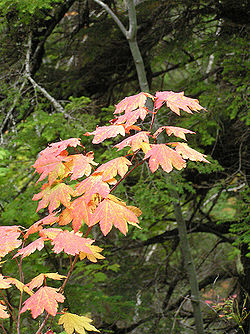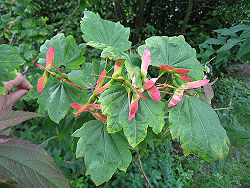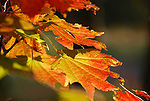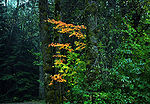Vine maple
| Vine maple |
|---|

|
| Scientific Classification |
|
| Binomial Name |
|
Acer circinatum |
| Samaras on a Vine Maple |
Vine maple is a species of Maple known by the scientific name Acer cirinatum. The Vine Maple will become too heavy to stand erect and will bend over sometimes growing into the dirt, if this happens there is a chance that it could sprout a whole new maple! It is well known for is samaras or "helicopters" which are the fruit is produces.
Anatomy
This deciduous shrub or small tree grows from ten to twenty feet tall. The leaves of this plant are seven to nine centimeters which are usually round to cordate which is heart-shaped; these leaves are also double toothed. The bark of this small tree is smooth, thin, and ranging from greenish to bright reddish brown. [1] This long-lived, shade-tolerant tree has many different variations of growth forms. It can have erect or vertical stems, leaning, arched or curved outward, with their branch tips anchored by roots, or on the ground with the stems end faced up. When the conditions are good this tree can sometimes even reach up to 30 feet tall with and 8-12 inch diameter. The fruit on this tree are called samara, which are rose-colored. [2]
Reproduction
The Vine Maples main type of reproduction comes mostly from vegetative means instead of seed producing.
Seed Production: Seed production in a Vine maple starts at quite an early age down to about ten years. When the leaves are close to being half grown the Vine Maples flowers start to bloom, this happens during the Spring of course. These flowers appear at the end of the branches in small little clusters. Both male and female organs are in each flowers yet only one works. In saying this, it is only up to some of the flowers to become fruits on this tree. When they do the fruit is called a samara. When on the tree they start out as two samaras attached to each other which eventually separate. In these samaras are seeds, which are produced in small quantity annually. The seed that catches wind is released in autumn by the wind.
Vegetative Regeneration: The plants come out of the root crown, which is part of a root system where the stem arises. In early seral communities, which is an intermediate stage found in ecological succession in an ecosystem, Vine Maple distribution was primarily dependent on its distribution before it was disturbed. In these seral stands layering does not occur too often, but when some plants mature their stems become too long and big to stand up right and bend over from their weight. Sometimes when this happens they can grow into the ground and create a whole new root system.
Ecology
The Vine Maple is found in the Pacific Northwest and ranges from the Cascade Mountains to the coast and also from British Columbia to the northern part of California. They are mostly found on the west side of the cascades in Oregon. The Vine Maple can be found around the Douglas-fir, Western Hemlock, Western Redcedar, Port Orford-Cedar, and Sitka Spruce, mostly found on the west side of the mountains. On the Eastside though it can be found in in moist bottoms in the Ponderosa Pine forests.
In the summer the vine maples leaves are used as food for the black-tailed deer and elk. The buds and seeds of this plant provide food for lots of small birds and some small mammals. Chipmunks and Squirrels eat these and usually store them. many different birds use the seed stalks of these maples for their nests. Sheep and cattle also eat these shrubs.
This shrub has little nutritional value in the winter with up to 5% protein and high in fat while in the summer the protein gets up to as much as 13%.[3]
Uses
The Vine maple can be used for many different things. The wood itself is not usually straight its curved and twisted thus making it hard to build stuff with it. People made bows out of them because the wood is quite tough. However, the Native Americans usually stuck to yew when it came to making bows, but they used the vine maple for their fishing nets. The Vine maple stalks are also strong and the Native Americans used them to make baskets for carrying very heavy things like clams and camas roots. The Native Americans called this tree a "basket tree" because this is what they used to make their baskets. This was also used for making spoons, bowls, and for fishing for salmon. This Maple is today used for lots of landscaping. The sap on the vine maple, though colorless like water, is very sweet, almost like syrup and can be collected quite easily. [4]
Gallery
References
- Plant Information. 1997
- Acer circinatum Ronald J. U.S department of Agriculture. 1989
- Uses of Vine Maple Vine Maple Studio.







